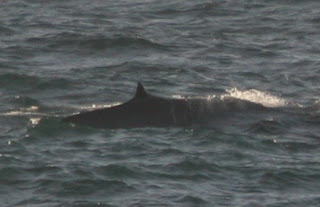Today, like
yesterday presented us with ideal conditions for sightings with small swell and
light winds. Needless to say after a good day of sightings yesterday we were
expecting another good day today. Our first sighting was of a group of 8 Pilot
Whales. Seeing these has fast become a daily occurrence. However as we looked
back over the photographs we had taken of the group we saw that there was at
least one Bottlenose Dolphin in the group. Things then died down for a few
hours until a blow was spotted about a kilometre off on the port side the
animal only blew a few times before disappearing into the deep. Things really
kicked off after dinner with 5 separate whale sightings with a total of 9
animals. This included at least 1 sperm whale which happily fluked for us when
deep diving allowing us to get a photo.
Sperm Whale (Paddy O'Dwyer)
During this
time there was another group of 6 pilot whales which we photographed, and a
group of 5 small cetaceans which were not willing to show themselves for a few
pictures. The other sightings are proving more difficult to identify. The photo
below gives a glimpse of 1 of the animals, if anyone has any thoughts on a
species ID we would be happy to hear them.
As yet unknown (Paddy O'Dwyer)
For a while
it seemed that all we had to do was look anywhere in the water and we would see
something. The large numbers of sightings in the evening corresponded with an
aggregation near the surface which was picked up by the echo sounder.
Surface aggregation hard to see. Thanks Brain (Canadian Marine Institute)
While the
cetaceans were putting on their best showing so far the birds were more elusive
and stayed clear of the boat making them difficult to identify. Even though
numbers were down on yesterday there were still plenty of birds around
including Great Skua, Pomarine Skua, Long tailed Skua, Fulmars and Manx
Shearwater.
So
here’s hoping for a similar day tomorrow with plenty of chances to see more
birds and cetaceans.


























